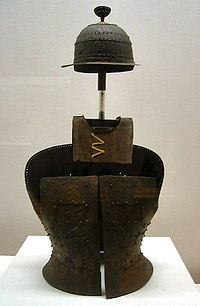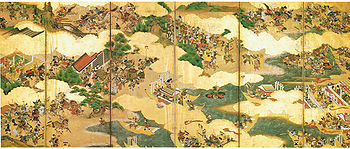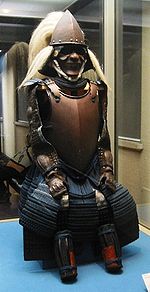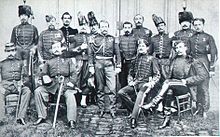- Military history of Japan
-
History of Japan 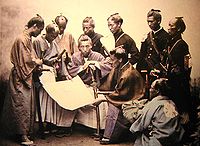
- Paleolithic 35,000–14,000 BC
- Jōmon period 14,000–300 BC
- Yayoi period 300 BC–250 AD
- Kofun period 250–538
- Asuka period 538–710
- Nara period 710–794
- Heian period 794–1185
- Kamakura period
1185–1333- Kenmu restoration
1333–1336
- Kenmu restoration
- Muromachi period (Ashikaga)
1336–1573- Nanboku-chō period
1336–1392 - Sengoku period
1467–1573
- Nanboku-chō period
- Azuchi–Momoyama period
1568–1603 - Edo period (Tokugawa)
1603–1868 - Meiji period 1868–1912
- Taishō period 1912–1926
- Shōwa period 1926–1989
- Heisei period 1989–present
- Lost Decade
- Empire of Japan (prewar)
1868–1945 (political entity) - Japan (postwar)
1945–present (political entity) - Economic history
-
- History of currency
- Educational history
- Military history
- Naval history
- History of seismicity
The military history of Japan is characterised by a long period of feudal wars, followed by domestic stability, and then rampant imperialism. It culminates with Japan's defeat by the Allies in World War II. Since then, Japan's constitution has prohibited the use of military force to wage war against other nations.
Unless one counts the Allied occupation following World War II, the Japanese main islands have never been successfully invaded in recorded history.
Contents
Prehistory
Recent archaeological research has uncovered traces of wars as far back as the Jōmon period (ca. 10,000–300 BC) between the various tribes existing on the Japanese Archipelago. Some theorists believe that shortly after the Yayoi period (ca. 300 BC – 250 AD) horse riders from the Korean Peninsula invaded southern Kyūshū, then spread to all the way to northern Honshū. This is when horse-riding and iron tools were first introduced to the islands.
Jōmon Period (ca. 10,000–300 BC)
Near the end of the Jōmon period (ca. 300 BC), villages and towns became surrounded by moats and wooden fences due to increasing violence within or between communities. Some remains were found with head and arrow injuries. Battles were fought with weapons like the sword, sling, spear, and bow and arrow.
Yayoi Period (300 BC – 250 AD)
Bronze goods and bronze-making techniques from the Asian mainland reached what is now Japan as early as the 3rd century BC. It is believed that horses were introduced to Japan near the end of this time (and well into the early Yamato era), as were bronze and later iron implements and weapons. Archaeological findings suggest that bronze and iron weapons were not used for war until later, particularly at the beginning of the Yamato era, as the metal weapons found from the remains do not show wear consistent with use as weapons. The transition from the Jōmon to Yayoi, and later to the Yamato, period is likely to have been characterized by violent struggle as the natives were soon displaced by the invaders and their vastly superior military technology.[1]
Around this time, the San Guo Zhi first refer to the nation of Wo (or "Wa" in Japanese). According to this work, Wa was "divided into more than 100 tribes" and for some 70 or 80 years there were many disturbances and warfare. About 30 of the communities had been united by a sorceress-queen named Pimiko (or "Himiko" in Japanese). She sent an emissary named Nashonmi with a tribute of slaves and cloth to Daifang in China, establishing diplomatic relations with Cao Wei (the Chinese kingdom of Wei). Cao was competing with the three kingdoms.
Ancient and Classical Japan
By the end of the 4th century, the Yamato clan was well settled on the Nara plain with considerable control over the surrounding areas. Five kings of Wa sent envoys to China for the dominion of the Japanese Islands and a Korean peninsula. The Nihon Shoki claims that Yamato was even strong enough to have sent an army against the powerful state of Goguryeo, which dominated the Korean Peninsula at the time. Yamato Japan had close relations with the southwestern Korean kingdom of Baekje from which it received Buddhism and Chinese writing system. When Baekje requested help from the Japanese, they were then defeated by an alliance of Tang China and Silla in Battle of Baekgang in 663. As a result, the Japanese were banished from the Korean Peninsula. To defend the Japanese Archipelago, a military base was constructed in Dazaifu, Fukuoka of Kyushu.
Near the end of the Heian period, the samurai became a powerful political force, thus starting the feudal period.
Yamato Period (250–710 AD)
Ancient Japan had close ties with the Gaya Confederacy in the Korean Peninsula as well as with the Korean kingdom of Baekje. Gaya exported abundant quantities of iron armor and weapons to Wa (there was an abundance of naturally-occurring iron in that region) and there may have even been a Japanese military post there with Gaya and Baekje cooperation.[citation needed]
In 552, the ruler of Baekje appealed to Yamato for help against its enemies, the neighboring Silla. Along with his emissaries to the Yamato court, the Baekje king sent bronze images of Buddha, some Buddhist scriptures, and a letter praising Buddhism. These gifts triggered a powerful burst of Japanese interest in Buddhism.
The Battle of Baekgang (白村江) took place in 663, near the conclusion of the Korean Three Kingdoms period. The Nihonshoki records that Yamato sent 32,000 troops and 1,000 ships to support Baekje against the Silla-Tang force. However, these ships were intercepted by a Silla-Tang fleet and defeated. Baekje, without aid and surrounded by Silla and Tang forces on the land, collapsed. A hostile Silla (Silla was a rival of Baekje, and as Baekje had a close relationship with Wa Japan, Silla viewed Wa Japan also as a rival and was hostile to it) prevented Japan from having any further meaningful contact with the Korean Peninsula until far later in time. The Japanese then turned directly to China.
Nara Period (710–784 AD)
In nearly all of the ways that matter, the Nara period was the beginning of Japanese culture becoming what we today think of as Japanese. It was in this period that Japan first gained Buddhism, the Chinese writing system, and law system. The country was united and centrally governed for the first time, and much of the basics of the feudal system were set down.
While much of the discipline, weapons, armor, and technique of the samurai was probably not developed yet, the skeleton of the Japanese feudal warrior began here. Mounted archers, swordsmen, and spearmen fought with weapons not too different from those of any other culture, across the world, who had the same level of technology.
Succession disputes were prevalent here, just as in most of the later periods, and the Nara period also saw the first Shogun, Sakanoue no Tamuramaro.
Heian Period (794–1185 AD)
The Heian Period, militarily, consisted mainly of conflicts and battles between samurai clans over political power and influence, especially fought over control over the line of succession to the Chrysanthemum Throne. The Imperial family struggled against the control of the Fujiwara clan, which almost exclusively monopolized the post of regent (Sesshō and Kampaku). Feudal conflicts over land, political power, and influence eventually culminated in the Genpei War between the Taira and Minamoto clans, and a large number of smaller clans allied with one side or the other. The end of the Genpei War brought about the end of the Heian and the beginning of the Kamakura period.
During this period, samurai were still, largely, archers first and foremost, before swordsmen. Nearly all duels and battles began with an exchange of arrowfire, before single combat was entered, with sword and dagger.
The 12th century conflicts, particularly the Genpei War, and the establishment of the Kamakura shogunate that followed, mark the rise of the samurai class over the court nobility (kuge). Shogunates, essentially military governments, dominated Japanese politics for nearly seven hundred years (1185-1868), subverting the power of the Emperor and of the Court.
Militarily speaking, this period also marks a crucial shift from a state that was united in relative peace against outside threats, to one that did not fear invasion and instead focused on internal division and clashes between societal factions. With the exception of the Mongol invasions of the 13th century, Japan did not face considerable outside threats until the arrival of Europeans in the 16th century. Thus, pre-modern Japanese military history is largely defined not by wars with other states but by internal conflicts.
Feudal Japan
This period is marked by the departure from tournament-like battles, and a move to massive clashes of clans for the control of Japan. In the Kamakura period, Japan successfully repulsed Mongol invasions and this started a change to conscripted armies with a core of samurai as an elite force and as commanders. Following roughly fifty years of bitter fighting over control of the Imperial succession, the Muromachi period under the Ashikaga shogunate saw a brief period of peace before the traditional systems of administration under the Court collapsed. Provincial governors and other officials under the Imperial government transformed into a new class of daimyo (feudal lords), and bringing the archipelago into a period of 150 years of fractious disunity and war.
Kamakura Period (1185–1333)
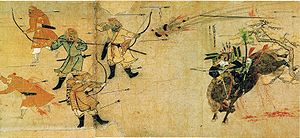 The Samurai Suenaga facing Mongols, during the Mongol invasions of Japan. Mōko Shūrai Ekotoba (蒙古襲来絵詞), circa 1293.
The Samurai Suenaga facing Mongols, during the Mongol invasions of Japan. Mōko Shūrai Ekotoba (蒙古襲来絵詞), circa 1293.
Having subdued their rivals, the Taira clan, the Minamoto samurai clan established the Kamakura shogunate, which brought a period of peace. The only battles fought between Japanese in this period, prior to those that brought the fall of the shogunate, consisted of agents of the Minamoto suppressing rebellions or the like.
The Mongols, who controlled China at the time under the Yuan Dynasty, attempted to invade Japan twice in the 13th century, marking the key military events of the Kamakura period, and two of the very few invasion attempts upon Japan in the 2nd millennium. In early October 1274, the Battle of Bun'ei began with a combined force of Mongols and Koreans seizing Tsushima, and then attacking Kyūshū, landing at Hakata Bay. On October 19, they lost many battle ships due to typhoon and the remaining troops retreated. Anticipating a second assault, the shogunate organized the construction of walls and fortresses along the shore, and gathered forces to defend against further invasions. A second invasion attempt was made in 1281, in what has come to be known as the Battle of Kōan; the Mongol-led forces retreated after losing many ships due to a typhoon once again.
The equipment, tactics, and military attitudes of the samurai and their Mongol opponents differed greatly, and while both invasions failed miserably, their impact on developments and changes in samurai battle were quite significant. The samurai remained attached to ideas of single combat, that of honorable battle between individual warriors, and to certain ritual elements of battle, such as a series of archery exchanges conducted before entering into hand-to-hand fighting. The Mongols, of course, knew nothing of Japanese conventions, and were arguably much more organized in their strike tactics. They did not select individual opponents with whom to conduct honorable duels, but rode forth on horseback, with various forms of gunpowder weapons and the now-famous Mongol bow, charging into enemy lines and killing as many as they could without regard to Japanese conceptions of protocol. Though archery and mounted combat were central to Japanese warfare as well at this time, the Mongols remain famous even today for their prowess in these matters. The ways samurai tactics and attitudes were affected directly by these experiences, and their extent, are of course difficult to ascertain, but were certainly significant.
Muromachi Period (1336–1467)
The shogunate fell in the wake of the 1331 Genkō War, an uprising against the shogunate organized by the Emperor Go-Daigo. After a brief period under true Imperial rule, the Ashikaga shogunate was established in 1336, and a series of conflicts known as the Nanboku-chō Wars began. For over fifty years, the archipelago became embroiled in disputes over control of the Imperial succession, and thus over the country.
Battles grew larger in this period, and were less ritualized. Though single combats and other elements of ritual and honorable battle remained, organized strategies and tactics under military commanders began to emerge, along with a greater degree of organization of formations and divisions within armies. It was in this period as well that weaponsmithing techniques emerged creating so-called "Japanese steel" blades, flexible yet extremely hard and sharp; the katana, and myriad similar or related blade weapons, appeared at this time and would dominate Japanese arms, relatively unchanged, through the mid-20th century. As a result, it was also during this period that the shift of samurai from archers to swordsmen began in a significant way.
Sengoku Period (1467–1603)
Less than a century after the end of the Nanboku-chō Wars, peace under the relatively weak Ashikaga shogunate was destroyed by the outbreak of the Ōnin War, a roughly ten-year struggle that converted the capital of Kyoto into a battlefield and a heavily fortified city that suffered severe destruction.
The authority of both the shogunate and the Imperial Court all but collapsed, and provincial Governors (shugo) and other local samurai leaders emerged as the daimyo, who would battle each other, religious factions (e.g. the Ikkō-ikki) and others for land and power for the next 150 years or so. The period has come to be called Sengoku (戦国), after the Warring States period in ancient Chinese history. Over one hundred domains clashed and warred throughout the archipelago, as clans rose and fell, boundaries shifted, and some of the largest battles in all of global pre-modern history were fought.
A great many developments and significant events took place during this period, ranging from advances in castle design to the advent of the cavalry charge, the further development of campaign strategies on a grand scale, to the significant changes brought on by the introduction of firearms.
Army compositions changed and grew more strategic; masses of ashigaru footsoldiers, armed with long lances (yari) served a role alongside mounted samurai, archers, and later, gunners. Siege tactics and weaponry were exceedingly rare until the modern era. Naval battles likewise consisted of little more than using boats to move troops within range of bow or arquebus, and then into hand-to-hand fighting.
The Hōjō clan, in and around the Kantō area, were among the first to establish networks of satellite castles, and the complex use of these castles both for mutual defense and coordinated attacks. The Takeda, under Takeda Shingen, developed the Japanese equivalent of the cavalry charge; though debate continues today as to the force of his charges, and the appropriateness of the term, comparing them to Western cavalry charges, it is evident from contemporary sources that it was a revolutionary development, and powerful against defenders unused to it. Battles of particular interest or significance are too numerous to list here, but suffice it to say that this period saw a myriad of strategic and tactical developments, and some of the longest sieges and largest battles in the history of the pre-modern world.
Azuchi-Momoyama Period (1568–1600)
This period, named for the increasingly important castle-cities, is marked with the introduction of firearms, after contact with the Portuguese, and a further push towards all-out battle, away from individual combats and the influences of concepts of personal honor and bravery.
The arquebus was introduced to Japan in 1543, by Portuguese onboard a Chinese ship that crashed upon the tiny island of Tanegashima in the southernmost parts of the Japanese archipelago. Though their introduction was not seen to have particularly dramatic effects for several decades, by the 1560s, thousands of gunpowder weapons were in use in Japan, and began to have revolutionary effects upon Japanese battle tactics and strategies, army compositions, and castle architecture.
The 1575 Battle of Nagashino, in which about 3,000 arquebusiers led by Oda Nobunaga cut down charging ranks of thousands of samurai, remains one of the chief examples of the effect of these weapons. Highly inaccurate, and taking a long time to reload, arquebusses, or teppō (鉄砲) as they are called in Japanese, did not win battles on their own. Oda Nobunaga, Toyotomi Hideyoshi, and other commanders, developed tactics that honed arquebus use to the greatest advantage. At Nagashino, Nobunaga's gunners hid behind wooden barricades, embedded with large wooden spikes to ward off cavalry, and took turns firing volleys and reloading.
As in Europe, the debilitating effects of wet (and therefore largely useless) gunpowder were decisive in a number of battles. But, one of the key advantages of the weapon was that unlike bows, which required years of training largely available only to the samurai class, guns could be used by relatively untrained footmen. Samurai stuck to their swords and their bows, engaging in cavalry or infantry tactics, while the ashigaru wielded the guns. Some militant Buddhist factions, began to produce firearms in the foundries normally employed to make bronze temple bells. In this manner, the Ikkō-ikki, a group of monks and lay religious zealots, turned their Ishiyama Honganji cathedral-fortress into one of the most well-defended fortresses in the country. The ikki and a handful of other militant religious factions thus presented significant powers unto themselves, and fought fierce battles against some of the chief generals and samurai clans in the archipelago.
Though Sengoku battles continued to rage as they had for the previous century, growing larger and more tactically complex, it was at this time that the many "warring states" began to be united, first under Oda Nobunaga, then under Toyotomi Hideyoshi, and finally by Tokugawa Ieyasu.
In 1592 and 1598 Toyotomi Hideyoshi organized a 160,000[citation needed] army and navy for the conquest of China's Ming Dynasty by way of Korea, after the latter's refusal to allow Japanese forces to march through. Japan completed the occupation of a Korean peninsula in three months. However, a Chinese army was sent to a Korean peninsula by the Korean king's petition. The supply line of a Japanese army was cut by Korean people's guerrilla though the sniper in Japan overwhelmed the Chinese cavalry. Before long , It becomes impossible for a Japanese army to maintain the occupation of a Korean peninsula.After Hideyoshi's death, the Council of Five Elders ordered the remaining Japanese forces in Korea to retreat.
Tokugawa Ieyasu, one of the regents, took control of most of the former leader's forces. In 1600 he won the battle of Sekigahara and solidified his rule. In 1603, he received the title of shogun, making him the nominal ruler of the entire country.
Edo Period (1603–1867)
This period was one of relative peace under the authority of the Tokugawa shogunate. This was a forced peace—maintained through a variety of measures that weakened the daimyo and ensured their loyalty to the shogunate. The Tokugawa peace was ruptured only rarely and briefly prior to the violence that surrounded the Meiji Restoration of the 1860s.
The siege of Osaka, which took place in 1614–1615, was essentially the last gasp for Toyotomi Hideyori, heir to Hideyoshi, and an alliance of clans and other elements who opposed the shogunate. A samurai battle on a grand scale, in terms of strategy, scale, methods employed, and the political causes behind it, this is widely considered the final conflict of the Sengoku period.
Outside of the siege of Osaka, and the later conflicts of the 1850s-60s, violence in the Edo period was restricted to small skirmishes in the streets, peasant rebellions, and the enforcement of maritime restrictions. Social tension in the Edo period brought a number of rebellions and uprisings, the largest of which was the 1638 Shimabara Rebellion. In the far north of the country, the island of Hokkaido was inhabited by Ainu villagers and Japanese settlers. In 1669 an Ainu leader, led a revolt against the Matsumae clan who controlled the region, it was the last mayor uprising against Japanese control of the region and it was put down in 1672. In 1789 another Ainu revolt, the Menashi-Kunashir Rebellion, was crushed.
The appearance of gunboat diplomacy in Japan in the 1850s, and the forced so-called "opening of Japan" by Western forces underscored the weaknesses of the shogunate and led to its collapse. Though the actual end of the shogunate and establishment of an Imperial government following Western modes was handled entirely peacefully, through political petitions and the like, the years surrounding the event were not an entirely bloodless revolution. Following the formal termination of the shogunate, the Boshin War (戊辰戦争 Boshin Sensō, literally "War of the Year of the Dragon") was fought in 1868-1869 between the Tokugawa army and a number of factions of nominally pro-Imperial forces to seize power and fill the gap thus created.
Modern Period
After a long peace, Japan rearmed by importing, then manufacturing Western weapons, and finally manufacturing weapons of Japanese design. During the Russo-Japanese War (1904–1905), Japan became the first Asian nation since Genghis Khan's Mongols to win a war against a European nation. In 1902 it became the first Asian nation to sign a mutual defense pact with a European nation, Britain.
Japan was also the last major power to enter the race of global colonization. Severely hampered by its still-developing industries, Japan started a war against the United States during World War II with less than one-tenth of the industrial capabilities of the U.S.
Japan has not participated in a major war as a combatant since being defeated in World War II. Even though Japan maintains a powerful defense force, its Constitution, originally drawn under the guidelines of General Douglas MacArthur in 1945, formally renounces war and the use of military force in aggressive or offensive ways. Japan also maintains a policy against the exporting of military hardware. In addition, Japan is the only nation with a space exploration program not to have nuclear weapons.
Meiji Period
Modern army established
From 1867, Japan requested various Western military missions in order to help Japan to modernize its armed forces. The first Foreign military mission in Japan was held by France in 1867. Captain Jules Brunet, initialy a French artillery advisor of the Japanese central government, eventually took up arms alongside the Shogun's army against the Imperial troops. His life inspired the movie The Last Samurai, starring Tom Cruise and Ken Watanabe.
In 1873, the Imperial government enacted the conscription law and established the Imperial Japanese Army. As class distinctions were all but eliminated in attempts to modernize and create a representative democracy, samurai lost their status as the only class with military obligations. A sensationalized depiction of this can also be seen in The Last Samurai.
Sino-Japanese War (1894–1895)
The Sino-Japanese War was fought against the forces of the Qing Dynasty of China in the Korean peninsula, Manchuria, and the coast of China. It was the first major conflict between Japan and an overseas military power in modern times.
The Treaty of Shimonoseki (下関条約 Shimonoseki Jyoyaku) signed between Japan and China ended the war. Through this treaty, Japan forced China to open ports for international trade and ceded the southern portion of China's Liaoning province as well as the island of Taiwan to Japan. China also had to pay a war indemnity of 200 million Kuping taels. As a result of this war, Korea ceased to be a tributary state of China, but fell into Japan's sphere of influence. However, many of the material gains from this war were lost by Japan due to the Triple Intervention.
Japanese invasion of Taiwan (1895)
The Japanese occupation of Taiwan was strongly resisted by various interests on the island, and was only completed after a full-scale military campaign requiring the commitment of the Imperial Guards Division and most of the 2nd and 4th Provincial Divisions. The campaign began in late May 1895 with a Japanese landing at Keelung, on the northern coast of Taiwan, and ended in October 1895 with the Japanese capture of Tainan, the capital of the self-styled 'Republic of Formosa'. The Japanese defeated regular Chinese and Formosan formations relatively easily but their marching columns were often harassed by guerilla formations. The Japanese responded with brutal reprisals, and sporadic resistance to their occupation of Taiwan continued until 1902.
Russo-Japanese War
The Japanese victory in the Russo-Japanese War of 1904-1905 marks the emergence of Japan as a major military power. Japan demonstrated that it could apply Western technology, discipline, strategy, and tactics in an effective war.
Taisho Period and World War I
1914: Japan was a member of the Allies during World War I and was rewarded with control of German colonies in the Pacific. The 70,000-strong Japanese force also intervened in Russia during the Russian Civil War, supporting the anti-Communist factions, but failed to achieve their objective and was forced to withdraw. A small group of Japanese cruisers and destroyers also participated in various missions in the Indian Ocean and Mediterranean Sea.
Showa Period and World War II
Already controlling an area directly surrounding the South Manchuria Railroad, Japan's Kwantung Army further invaded Manchuria (Northeast China) in 1931, following the Mukden Incident, in which they claimed to have had territory attacked by the Chinese (a few meters of the South Manchuria Railway was destroyed in a bombing sabotage). By 1937, Japan had annexed territory north of Beijing and, following the Marco Polo Bridge Incident, a full-scale invasion of China began. Japanese military superiority over a weak and demoralized Chinese Republican army allowed for swift advances down the eastern coast, leading to the fall of Shanghai and Nanjing (Nanking, then capital of the Republic of China) the same year. The Chinese suffered greatly in both military and civilian casualties. An estimated 300,000 civilians were killed during the first weeks of Japanese occupation of Nanjing, during the Nanking Massacre.
In September 1940, Germany, Italy, and Japan became allies under the Tripartite Pact. Germany, which had previously trained and supplied the Chinese army, halted all Sino-German cooperation, and recalled its military advisor (Alexander von Falkenhausen). In July 1940, the U.S. banned the shipment of aviation gasoline to Japan, while Imperial Japanese Army invaded French Indochina and occupied its naval and air bases in September 1940.
In April 1941, the Empire of Japan and the Soviet Union signed a neutrality pact and Japan increased pressure on the Vichy French and Dutch colonies in Southeast Asia to cooperate in economic matters. Following Japan's refusal to withdraw from China (with the exclusion of Manchukuo) and Indochina, United States, Great Britain and Netherlands imposed, on July 22, 1941, an embargo on gasoline while shipments of scrap metal, steel and other materials had virtually ceased. Meanwhile, American economic support to China began to increase.
Following the Japanese attack on Pearl Harbor and against several other countries on December 7, 1941, the United States, United Kingdom and the other Allies declared war; the Second Sino-Japanese War became part of the global conflict of World War II. Japanese forces initially experienced great success against Allied forces in the Pacific and South East Asia, capturing Thailand, Hong Kong, Malaya, Singapore, the Dutch East Indies, the Philippines and many Pacific Islands. They also made major offensives in Burma and air and naval attacks against Australia. The Allies turned the tide of war at sea in mid-1942, at the Battle of Midway. Japanese land forces continued to advance in the New Guinea and Solomon Islands campaigns but suffered significant defeats and/or were forced to retreat at the battles of Milne Bay, the Kokoda Track and Guadalcanal.
From 1943 onwards, hard-fought campaigns at the battles of Buna-Gona, the Tarawa, Philippine Sea, Leyte Gulf, Iwo Jima, Okinawa, and others resulted in horrific casualties, mostly on Japanese side, and produced further Japanese retreats. Very few Japanese ended up in POW camps, this may have been due to Japanese soldiers reluctance to surrender. The brutality of the conflict is exemplified by US troops taking body parts from dead Japanese soldiers as "war trophies" or "war souvenirs" and Japanese cannibalism.
Throughout the Pacific War the Japanese military engaged in war crimes, in particular the mistreatment of prisoners of war and civilians, on a scale comparable to that of Nazi Germany.[citation needed] Some estimate that around 6 million people were killed by Japanese forces, primarily Chinese civilians. These numbers are disputed given that between 1939–1945, more than 16 million civilians were injured in China alone. This was the largest civilian casualty count in any country. Mistreatment of Allied prisoners through forced labour and brutality received extensive coverage in the west. It is widely perceived that the Japanese government has failed to acknowledge the suffering caused by its forces and in particular the teaching of history in its schools has caused international protest.
On August 6 and August 9, 1945, the U.S. dropped two atomic bombs, on Hiroshima and on Nagasaki respectively. More than 200,000 people died as a direct result of these two bombings, during which the Soviet Union entered the war against Japan.
Japan surrendered on August 15, 1945 and a formal Instrument of Surrender was signed on September 2, 1945, on the battleship USS Missouri in Tokyo Bay. The surrender was accepted by General Douglas MacArthur as Supreme Allied Commander, with representatives of each Allied nation, from a Japanese delegation led by Mamoru Shigemitsu. A separate surrender ceremony between Japan and China was held in Nanking on September 9, 1945.
Following this period, MacArthur established bases in Japan to oversee the postwar development of the country. This period in Japanese history is known as the Occupation. U.S. President Harry Truman officially proclaimed an end of hostilities on December 31, 1946.
Over the course of the war, Japan displayed many significant advances in military technology, strategy and tactics. Among them were the Yamato class battleship, the Sensuikan Toku submarine bomber carriers, the Mitsubishi Zero fighters, and Kamikaze bombers.
Atlantis Documents
It is sometimes[when?] argued that the Japanese decision to attack the Allies was, in large part, influenced by the capture of British documents with regards to British forces, the defenses of Singapore, codes, and information on Australia and New Zealand, as well as an appraisal of Japanese intentions. These documents were captured by the German Hilfskreuzer (auxiliary cruiser) Atlantis, on 1940-11-11. Other elements show that Japanese military command chose to invade allied territory as a result of a failure to defend itself against Soviet forces in 1938-1939 during the Nomonhan Incident.
Post–World War II
After a period of U.S. occupation (1945–1952), Japan regained its independence. Japan was also forbidden to have a standing army or wage war by Article nine of its Constitution.
Although the Japanese constitution says "land, sea, and air forces, as well as other war potential, will never be maintained," the Jieitai (自衛隊), or Japan Self-Defense Forces were created shortly after the end of U.S. occupation. The Jieitai is one of the most technologically advanced armed forces in the world and Japanese military expenditures are the seventh highest in the world. Though the Treaty of Mutual Cooperation and Security, signed in 1960, allows for the continued presence of American military bases in Japan, most of them on Okinawa, no formal agreement was ever set by which Japan officially relies on the United States, United Nations, or anybody else for its defense.
In the aftermath of the Occupation, attempts were made by some administrations in Japan, particularly at the urging of the United States, to amend the Constitution and rearm. This was prevented by intense popular sentiment against this action, and against war in general, along with the attitudes and agendas of significant elements within the government. In 1967, Prime Minister Eisaku Satō outlined the Three Non-Nuclear Principles by which Japan stands against its production, or possession of nuclear weaponry. Similar ideas were expressed several years later against the production and export of conventional arms. The Diet of Japan is currently deliberating an amendment to the Constitution that would repeal Article Nine, and allow Japan to once again have projective military capacity.
For the time being, Japan has deployed the Jieitai to aid in a number of non-combat missions, especially those involving humanitarian aid, such as aiding the victims of the 1995 Kobe earthquake, providing administrative support to the United Nations Interim Force In Lebanon (UNIFIL) Norwegian Battalion (NORBATT) in the 1990s, and helping rebuild Iraq.
Some Japanese state a desire to have their own military due to fear of the growing power of China and the hostility of North Korea. They claim that the U.S. has failed to properly address these issues, and therefore Japan must grant itself "the power to defend itself".
In 2004, then-United Nations Secretary General Kofi Annan announced a plan to expand the number of permanent seats on the United Nations Security Council, and Japan seeks to gain one of those seats. Despite Japan's economic power and political influence, some debate whether or not a country with no standing military can be considered a "world power" that should have a permanent seat on the Council. Recent disputes with neighboring countries like China, Taiwan, South Korea, and Russia over territories such as the Senkaku Islands, Liancourt Rocks, and the Kuril Islands, as well as accusations of Japanese whitewashing of history in various textbook controversies have also complicated this process.
See also
- List of Japanese battles
- Battles of the Imperial Japanese Navy
- Greater East Asia War
- Military History
- World War II
- Imperial Japanese Army
- Imperial Japanese Navy
- History of Japan
- Japanese nationalism
- Japan Self-Defense Forces
References
- ^ 江上波夫 騎馬民族国家 ISBN 4122011264
- Gordon, David M. "The China-Japan War, 1931-1945" Journal of Military History (Jan 2006) v 70#1, pp 137–82. Historiographical overview of major books
- Sansom, George (1958). 'A History of Japan to 1334'. Stanford, California: Stanford University Press.
- Sansom, George (1961). "A History of Japan: 1334-1615." Stanford, California: Stanford University Press.
- Sansom, George (1963). "A History of Japan: 1615-1867." Stanford, California: Stanford University Press.
- Turnbull, Stephen (1998). 'The Samurai Sourcebook'. London: Cassell & Co.
- Turnbull, Stephen (2002). 'War in Japan: 1467-1615'. Oxford: Osprey Publishing.
Further reading
- Morton, Louis (2000 (reissue from 1960)). "Japan's Decision for War". In Kent Roberts Greenfield. Command Decisions. United States Army Center of Military History. CMH Pub 70-7. http://www.history.army.mil/books/70-7_04.htm.
Military history of Asia Sovereign
states- Afghanistan
- Armenia
- Azerbaijan
- Bahrain
- Bangladesh
- Bhutan
- Brunei
- Burma (Myanmar)
- Cambodia
- People's Republic of China
- Cyprus
- East Timor (Timor-Leste)
- Egypt
- Georgia
- India
- Indonesia
- Iran
- Iraq
- Israel
- Japan
- Jordan
- Kazakhstan
- North Korea
- South Korea
- Kuwait
- Kyrgyzstan
- Laos
- Lebanon
- Malaysia
- Maldives
- Mongolia
- Nepal
- Oman
- Pakistan
- Philippines
- Qatar
- Russia
- Saudi Arabia
- Singapore
- Sri Lanka
- Syria
- Tajikistan
- Thailand
- Turkey
- Turkmenistan
- United Arab Emirates
- Uzbekistan
- Vietnam
- Yemen
States with limited
recognition- Abkhazia
- Nagorno-Karabakh
- Northern Cyprus
- Palestine
- Republic of China (Taiwan)
- South Ossetia
Dependencies and
other territories- Christmas Island
- Cocos (Keeling) Islands
- Hong Kong
- Macau
Albania · Argentina · Australia · Austria (Anschluss) · Azerbaijan · Belarus · Belgium · Brazil · Bulgaria · Burma · Cambodia · Canada · Ceylon (Sri Lanka) · Channel Islands · China · Czechoslovakia · Denmark · Dutch East Indies (Indonesia) · Egypt · Estonia · Finland · France · Germany · Gibraltar · Greece · Greenland · Hong Kong · Hungary · Iceland · India · Iran · Iraq · Ireland · Italy · Japan · Laos · Latvia · Lithuania · Luxembourg · Malaya, North Borneo and Sarawak (Malaysia) · Manchukuo · Mexico · Mongolia · Nepal · Netherlands · New Zealand · Newfoundland · Norway · Philippines · Poland · Portugal · Romania · Singapore · Slovakia · South Africa · Soviet Union · Spain · Sweden · Switzerland · Thailand · Turkey · Ukraine · United Kingdom · United States · Vatican City · Vietnam · Yugoslavia
Wikimedia Foundation. 2010.

